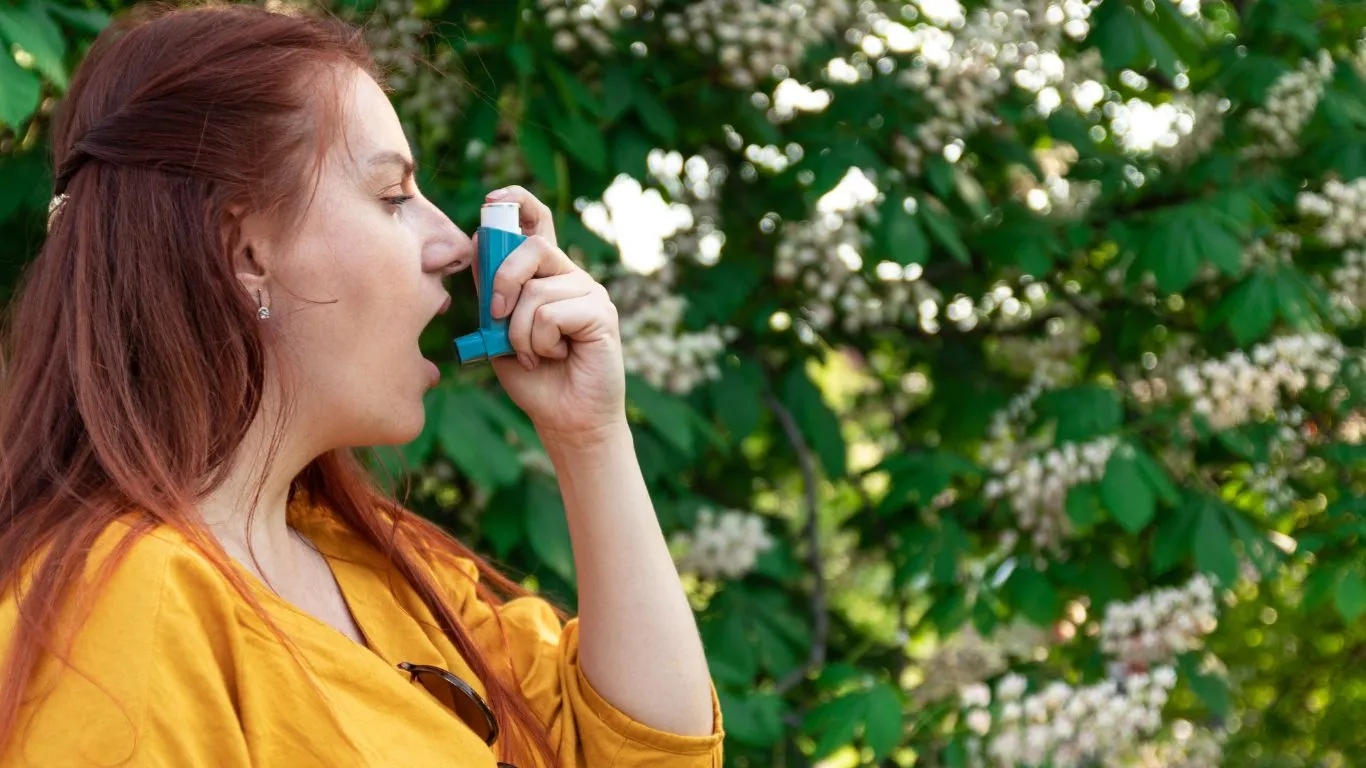Best Natural Asthma Treatments for Children to Boost Health
As a Pulmonary Nurse with years of experience in respiratory care, I’ve encountered countless families seeking advice on managing asthma in children. Asthma is a common condition that affects millions of children worldwide, and many parents are exploring natural asthma treatments for children as a way to complement traditional medical interventions. From my experience, I’ve seen firsthand how effective some of these natural approaches can be in not only helping children breathe easier but also improving their overall quality of life. In this article, we’ll explore some of the best natural asthma treatments that you can consider for your child.
Understanding Asthma and How It Affects Children

Asthma is a chronic condition that causes inflammation and narrowing of the airways, making it difficult for air to pass in and out of the lungs. This leads to symptoms such as coughing, wheezing, shortness of breath, and chest tightness. When it comes to children, asthma can be particularly challenging, as it may affect their ability to play, exercise, and engage in normal childhood activities.
Although asthma has no cure, it can often be managed effectively with medication and lifestyle changes. For many parents, finding ways to reduce their child’s reliance on medication is a priority, especially if they’re concerned about potential side effects. That’s where natural treatments come into play. But before diving into specific remedies, it’s important to understand what asthma is and how it manifests in children.
Common Asthma Triggers in Children
Asthma symptoms can be triggered by a variety of factors. Some of the most common triggers in children include:
- Allergens: Dust mites, pet dander, mold, and pollen are common allergens that can trigger asthma symptoms in children.
- Respiratory Infections: Colds, flu, and other respiratory infections can worsen asthma symptoms.
- Exercise: Physical activity can sometimes lead to an asthma flare-up, especially if the child is playing in cold or dry air.
- Environmental Factors: Air pollution, smoke, and chemical fumes can trigger asthma in susceptible children.
Identifying and avoiding these triggers is one of the first steps in managing asthma. In some cases, natural remedies can help reduce sensitivity to these triggers and improve overall lung health.
Natural Treatments for Asthma: What Works?

Now let’s talk about some natural asthma treatments that may help alleviate symptoms in children. It’s important to note that these treatments should complement, not replace, medical advice and prescribed medications. As always, consult with your pediatrician or pulmonologist before trying new treatments, especially if your child is already on asthma medication.
1. Honey and Lemon
One of the simplest and most soothing remedies for asthma is a warm mixture of honey and lemon. Honey has natural anti-inflammatory properties that can help soothe the throat and reduce irritation in the airways. Lemon, on the other hand, is packed with vitamin C, which can support immune health and reduce the frequency of asthma flare-ups. Together, these ingredients form a potent combination for respiratory health.
To make this remedy, mix a teaspoon of honey with a tablespoon of fresh lemon juice in warm water. Give this to your child once or twice a day, but make sure they’re not allergic to either ingredient first!
2. Ginger
Ginger is another powerhouse when it comes to natural asthma relief. Known for its anti-inflammatory properties, ginger can help open up the airways and reduce inflammation in the lungs. Studies have shown that ginger can help reduce bronchial constriction, a common symptom of asthma.
You can incorporate ginger into your child’s diet by making ginger tea or adding it to their food. For ginger tea, simply boil a few slices of fresh ginger in water for 10 minutes, then strain and cool the liquid before giving it to your child. Adding a little honey to the tea can make it more palatable.
3. Essential Oils: Eucalyptus and Lavender
Essential oils are becoming increasingly popular as a natural remedy for various health issues, including asthma. Both eucalyptus and lavender essential oils can help alleviate asthma symptoms. Eucalyptus oil contains eucalyptol, which can help open up the airways, while lavender oil is known for its calming effects, which may reduce stress and anxiety—two things that can trigger asthma attacks.
To use essential oils, diffuse them in your child’s room or apply them topically, diluted with a carrier oil, to their chest or back. Just be sure to use high-quality, pure essential oils, as low-quality oils can sometimes irritate the respiratory system instead of helping it.
4. Omega-3 Fatty Acids
Omega-3 fatty acids, found in foods like salmon, flaxseeds, and walnuts, are known for their anti-inflammatory effects. They may help reduce the inflammation in the airways that causes asthma symptoms. Some studies suggest that children with higher levels of omega-3s in their diet may have fewer asthma symptoms and flare-ups.
If your child isn’t a fan of fish, you can try supplementing with fish oil or flaxseed oil, or add more plant-based omega-3 sources like chia seeds and walnuts to their diet. Talk to your pediatrician about the appropriate dosage before giving your child any supplements.
Are Natural Asthma Treatments Safe for Children?

Many parents wonder if natural treatments are safe for children with asthma. While most natural remedies are safe when used appropriately, it’s crucial to remember that children with asthma require careful monitoring. Always check with a healthcare professional before trying new treatments, especially if your child is already on medication.
Some natural remedies, like honey, ginger, and essential oils, have been used for centuries and are generally considered safe. However, other remedies may cause allergic reactions in some children, so always introduce new treatments gradually and watch for any signs of sensitivity.
Also, while natural treatments can be beneficial, they should never replace the advice of a healthcare provider. In severe cases of asthma or when symptoms aren’t improving, prescription medications and professional care are still essential.
Herbal Remedies for Asthma: What Nature Can Offer

As a nurse, I often get asked about herbal remedies for asthma, especially when it comes to kids. While herbs aren’t a cure-all, they can definitely provide some relief and support your child’s asthma management plan. It’s essential to remember that herbs should always be used alongside prescribed medications, not as replacements. That said, let’s dive into some of the most effective herbal remedies that have worked wonders for some families I’ve worked with.
1. Butterbur
Butterbur is an herb that has gained attention for its potential to reduce inflammation and ease asthma symptoms. Research has shown that butterbur can help reduce airway inflammation, making it easier for children to breathe. This herb has been particularly helpful for those who suffer from seasonal asthma triggered by pollen.
It’s important to note that butterbur should only be used in its purified form. Raw butterbur contains compounds that can be toxic to the liver, so it’s crucial to use a properly processed supplement. Always consult with your child’s doctor before introducing any herbal supplement into their routine.
2. Licorice Root
Licorice root is another herbal remedy known for its anti-inflammatory and immune-boosting properties. In children with asthma, licorice root may help calm inflammation in the airways and soothe respiratory discomfort. It has been used in traditional medicine for centuries to treat respiratory issues, and modern studies support its efficacy in reducing asthma symptoms.
However, licorice root should be used cautiously, as it can raise blood pressure and may not be suitable for children with heart issues. Again, consult with your pediatrician before using licorice root in any form, and make sure to monitor your child’s health closely when using it.
3. Mullein
Mullein is a lesser-known herb, but it has some impressive respiratory benefits. This herb is often used to treat chronic coughs, colds, and other lung conditions. Mullein has natural expectorant properties, meaning it helps to loosen and clear mucus from the airways, which is especially helpful for kids with asthma who experience frequent coughing or wheezing.
Mullein can be used as a tea or in tincture form. If you choose to use mullein tea, steep the dried flowers in hot water for 10–15 minutes and give it to your child in small amounts. Be sure to check for any allergies or sensitivities before using it.
Dietary Changes for Better Asthma Management

As a nurse, I’ve seen how diet plays a critical role in managing asthma. While it’s not always the first thing that comes to mind, the foods your child eats can have a big impact on asthma control. Certain foods can trigger asthma symptoms, while others can reduce inflammation and improve overall lung health. Let’s explore some dietary changes that might help your child with asthma breathe easier.
1. Anti-inflammatory Foods
Asthma is an inflammatory condition, so it makes sense that anti-inflammatory foods can help keep symptoms at bay. Foods rich in omega-3 fatty acids, such as salmon, chia seeds, and walnuts, can help reduce airway inflammation. These foods have been linked to a decrease in asthma symptoms, and many families I work with have found that incorporating them into their child’s diet makes a noticeable difference.
Additionally, fruits and vegetables high in antioxidants—like berries, leafy greens, and carrots—can help protect the lungs from damage caused by inflammation. These foods also support the immune system, which is crucial for children with asthma who are more prone to infections.
2. Avoiding Dairy and Processed Foods
For some children with asthma, dairy products and processed foods can trigger symptoms. Dairy, in particular, can increase mucus production, making it harder for children to breathe. While this doesn’t apply to every child, it’s something worth considering if your little one’s asthma symptoms seem to worsen after consuming dairy.
Processed foods, which are often high in artificial additives, preservatives, and sugars, can also contribute to inflammation and trigger asthma flare-ups. If you suspect that certain foods might be triggering your child’s asthma, consider keeping a food journal to track their diet and symptoms. This can help identify any patterns and guide you toward healthier options.
3. Staying Hydrated
It’s easy to forget how important hydration is, especially when your child is feeling well. But staying hydrated is essential for children with asthma. Proper hydration helps thin mucus in the airways, making it easier to breathe. I always recommend that parents encourage their kids to drink water throughout the day, especially when the weather is hot or dry.
In addition to water, herbal teas like chamomile or ginger tea can be soothing for children with asthma. These teas can also help relax the airways and ease inflammation, offering additional benefits for respiratory health.
Breathing Techniques and Exercise: Helping Your Child Breathe Easier

Physical activity and exercise are critical for children’s health, but for children with asthma, it can sometimes feel like a tricky balance. On one hand, exercise can improve lung capacity and overall fitness, which is beneficial for asthma management. On the other hand, intense physical activity can sometimes trigger asthma symptoms, especially if the child is breathing heavily in cold or dry air.
One of the things I recommend to parents is teaching their children breathing techniques that can help reduce asthma flare-ups during exercise. Diaphragmatic breathing, also known as belly breathing, is a simple but effective technique that can help children control their breath and reduce the likelihood of wheezing or shortness of breath during physical activity.
1. Diaphragmatic Breathing
Diaphragmatic breathing involves breathing deeply into the diaphragm rather than shallow chest breathing. This type of breathing helps increase lung capacity and makes breathing more efficient. To teach your child diaphragmatic breathing, encourage them to place one hand on their chest and the other on their belly. Instruct them to inhale deeply through their nose, allowing their belly to rise, and exhale slowly through their mouth. Practice this technique together regularly so your child can use it when needed during physical activity.
2. Yoga and Relaxation Techniques
Yoga and relaxation exercises can also help children with asthma manage their symptoms. Yoga helps improve lung capacity, flexibility, and strength, which can be beneficial for asthma patients. Certain poses, like the child’s pose and the cat-cow stretch, can help open up the chest and improve breathing.
Incorporating yoga or relaxation techniques into your child’s daily routine can help them stay calm, reduce stress, and manage their asthma more effectively. Plus, it’s a fun way for them to engage in physical activity without putting too much strain on their lungs.
Environmental Changes to Manage Asthma Naturally

Along with herbal remedies and dietary adjustments, making environmental changes is one of the most impactful ways to help manage your child’s asthma. In fact, one of the first things I recommend to parents when they’re looking for natural asthma treatments is to evaluate their home environment. Asthma triggers like dust, mold, pet dander, and air pollution can worsen symptoms, so modifying the home environment can be a game-changer in asthma management.
1. Keep the Home Clean and Allergen-Free
As a Pulmonary Nurse, I’ve seen how critical it is to keep the home environment as clean and allergen-free as possible. Dust mites, pet dander, and mold are common asthma triggers, so eliminating these from your home can significantly reduce asthma flare-ups.
Start by regularly vacuuming and dusting your home. If you have carpets, consider switching to hardwood or tile flooring, as carpets tend to trap allergens. Also, wash bed linens and stuffed animals frequently in hot water to kill dust mites. Using a high-efficiency particulate air (HEPA) filter for vacuum cleaners and air purifiers can make a big difference as well.
If your child is allergic to pet dander, keeping pets out of bedrooms and using a HEPA air purifier in living areas can help reduce exposure. If mold is an issue in your home, try to fix any leaks and keep humidity levels under control, as mold thrives in damp environments.
2. Consider Natural Air Purifiers
Sometimes, it’s impossible to eliminate all allergens from the air, especially if you live in a city or an area with high levels of air pollution. In these cases, air purifiers can help. I recommend using air purifiers that feature HEPA filters, which are designed to trap even the smallest particles like pollen, pet dander, and dust. These purifiers can be especially helpful if your child’s asthma is triggered by environmental pollutants or allergens from outside.
Also, if you live in an area with a lot of outdoor air pollution, try to keep windows closed on days when air quality is poor. Some parents I’ve worked with even use indoor plants to purify the air naturally. Plants like peace lilies and spider plants have been known to help filter out harmful toxins in the air, making them a great option for asthma-friendly homes.
The Role of Stress and Anxiety in Asthma

While we often focus on physical triggers for asthma, it’s also important to consider the role of stress and anxiety. In my years of nursing experience, I’ve seen how emotional stress can lead to or exacerbate asthma attacks, especially in children. Stress can cause tightness in the chest and make it harder to breathe, so managing your child’s emotional well-being is just as important as managing physical triggers.
1. Relaxation Techniques to Reduce Stress
One way to help your child cope with stress is through relaxation techniques. Relaxing the body can make a big difference in controlling asthma symptoms. Breathing exercises, as I mentioned earlier, are an excellent way to reduce stress while also improving lung function. Techniques like progressive muscle relaxation, where your child tenses and then relaxes different muscle groups, can help release built-up tension.
Another great option is mindfulness meditation. This practice encourages your child to focus on their breath and clear their mind of any distractions. There are even kid-friendly mindfulness apps and videos that guide children through short meditation sessions. If you’re unsure where to start, you might want to try some calming activities like reading, drawing, or yoga together to help your child unwind after a long day.
2. Encourage Healthy Sleep Habits
Sleep is another crucial element in managing asthma, and many children with asthma have difficulty sleeping due to nighttime symptoms. This is often referred to as “nocturnal asthma,” where asthma symptoms worsen at night. Poor sleep can lead to increased stress, which can in turn exacerbate asthma symptoms. Helping your child establish a consistent bedtime routine and creating a relaxing sleep environment can help reduce asthma flare-ups during the night.
Consider keeping the bedroom free of allergens by washing bedding regularly and using hypoallergenic pillows and mattress covers. A cool, dark room with good ventilation can also promote better sleep. If your child’s asthma symptoms persist at night, be sure to discuss it with your pediatrician or asthma specialist.
When to Seek Professional Help
While natural asthma treatments can be incredibly helpful, it’s important to know when to seek professional help. If your child’s asthma symptoms are not well-controlled despite using natural remedies, or if they experience frequent flare-ups, it’s time to consult a doctor. Asthma is a chronic condition that requires regular monitoring, and sometimes prescription medications are necessary to keep it under control.
Remember, natural treatments should be viewed as complementary to traditional asthma care, not as substitutes for professional medical advice. If your child has an asthma attack, don’t hesitate to call for emergency help. A healthcare provider can provide a tailored asthma management plan that includes both natural and conventional treatments.
Conclusion: A Balanced Approach to Asthma Management
Managing asthma in children can be challenging, but with the right combination of natural treatments, environmental adjustments, and medical care, it’s possible to help your child live a more comfortable and active life. As a nurse, I’ve seen the benefits of incorporating natural remedies into a comprehensive asthma management plan. However, always remember that each child is different, and what works for one may not work for another. Be patient, and be sure to work closely with your pediatrician or asthma specialist to find the best approach for your child.
Disclaimer
The information provided in this article is based on personal experience as a Pulmonary Nurse and general knowledge of asthma management. It is not intended to replace professional medical advice. Always consult with a healthcare provider before trying any new treatments or making significant changes to your child’s asthma management plan. Individual responses to treatments may vary, and what works for one child may not work for another. If your child experiences a severe asthma attack or symptoms that do not improve with treatment, seek medical attention immediately.
For more information on asthma and natural treatments, you can visit trusted sources such as National Institutes of Health (NIH) and Health.com.

Bianca Nala is a compassionate Nurse Practitioner with a strong background in primary and respiratory care. As a health writer for Healthusias.com, she combines her clinical expertise with a talent for clear, relatable storytelling to help readers better understand their health. Bianca focuses on topics like asthma, COPD, chronic cough, and overall lung health, aiming to simplify complex medical topics without losing accuracy. Whether she’s treating patients or writing articles, Bianca is driven by a single goal: making quality healthcare knowledge accessible to everyone.






